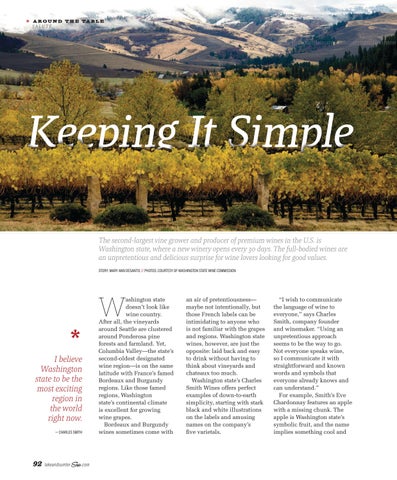* SAArL UoTuÉ n d
T h e Ta b l e
Keeping It Simple The second-largest vine grower and producer of premium wines in the U.S. is Washington state, where a new winery opens every 30 days. The full-bodied wines are an unpretentious and delicious surprise for wine lovers looking for good values. STORY: MARY ANN DESANTIS // PHOTOS: COURTESY OF WASHINGTON STATE WINE COMMISSION
W * I believe Washington state to be the most exciting region in the world right now. — CHARLES SMITH
92
lakeandsumter
.com
ashington state doesn’t look like wine country. After all, the vineyards around Seattle are clustered around Ponderosa pine forests and farmland. Yet, Columbia Valley—the state’s second-oldest designated wine region—is on the same latitude with France’s famed Bordeaux and Burgundy regions. Like those famed regions, Washington state’s continental climate is excellent for growing wine grapes. Bordeaux and Burgundy wines sometimes come with
an air of pretentiousness— maybe not intentionally, but those French labels can be intimidating to anyone who is not familiar with the grapes and regions. Washington state wines, however, are just the opposite: laid back and easy to drink without having to think about vineyards and chateaux too much. Washington state’s Charles Smith Wines offers perfect examples of down-to-earth simplicity, starting with stark black and white illustrations on the labels and amusing names on the company’s five varietals.
“I wish to communicate the language of wine to everyone,” says Charles Smith, company founder and winemaker. “Using an unpretentious approach seems to be the way to go. Not everyone speaks wine, so I communicate it with straightforward and known words and symbols that everyone already knows and can understand.” For example, Smith’s Eve Chardonnay features an apple with a missing chunk. The apple is Washington state’s symbolic fruit, and the name implies something cool and









